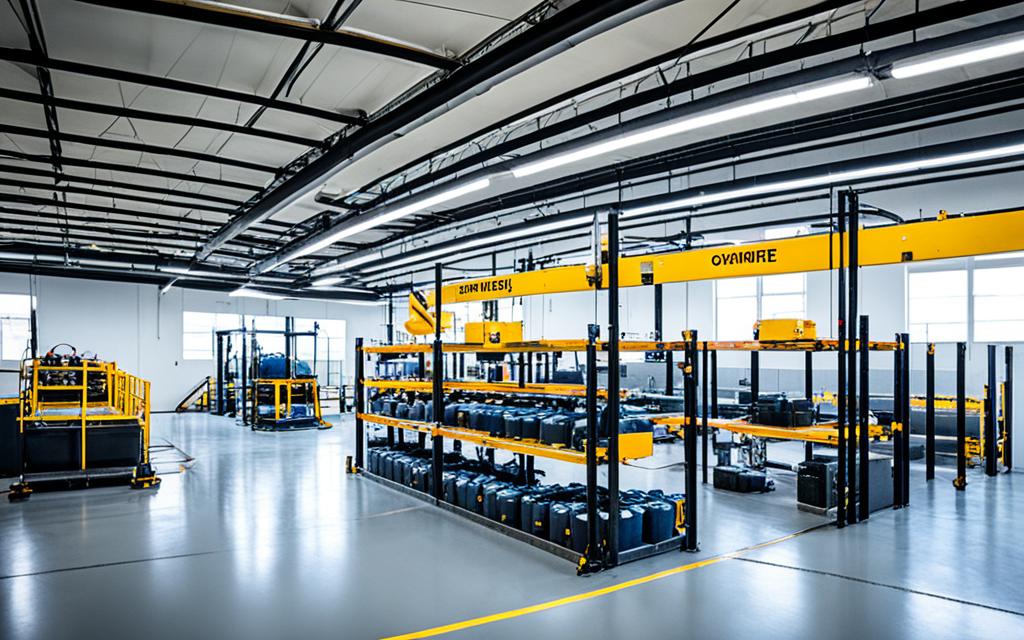Have you ever thought about making workplace safety more than just following rules?
SAP HSE (Health, Safety, and Environment) solutions offer a big chance for companies to change their safety culture. With new tech like real-time data analytics, businesses can make things run smoother and focus more on preventing accidents. Let’s look at why SAP HSE is key for companies wanting to improve safety at work.
Introduction to SAP HSE Solutions
SAP HSE solutions are a big step forward in industrial safety. They bring together health, safety, and environmental rules in one place. These systems make safety processes easier and help companies follow the law while working better.
SAP HSE can handle many safety areas in one system. This helps companies follow rules and make a safe work culture. By using data, companies can check on safety and make their work better.
Now, making the workplace safe is a top priority for many industries. Using SAP HSE has led to fewer accidents and lower legal costs. It keeps workers safe and helps a company look good and stay strong.
In short, SAP HSE solutions are key for better health, safety, and environment practices in any company. As they get better, they keep making workplaces safer in many fields.
Importance of Health and Safety Management

In today’s workplace, health and safety management is key. It helps create a safe culture among employees. Not focusing on safety can cause more accidents, lower morale, and big financial losses.
Studies show that good health and safety programs can cut workplace accidents by up to 40%. This shows that putting safety first boosts productivity and efficiency.
Having a strong safety plan helps manage risks better. It makes employees feel important and safe. This leads to trust and open talks about safety, making the workplace safer.
Leaders need to understand how poor safety can hurt their business. Investing in safety is crucial for a positive work environment.
| Consequences of Poor Health and Safety Management | Impact on Workplace |
|---|---|
| Increased Accidents | Higher injury rates, leading to operational disruptions |
| Low Employee Morale | Decreased job satisfaction and motivation |
| Hefty Fines | Financial strain due to penalties and compensation claims |
| Reputation Damage | Loss of trust from clients and stakeholders |
Key Features of SAP HSE Solutions
SAP HSE has many features to help manage health and safety in companies. It has strong tools for reporting incidents that make documenting them easier. These tools help record incidents fast, allowing for quick action and lowering risks. Using automated reporting in SAP cuts down on mistakes and speeds up responses.
Incident Reporting Tools
The tools for reporting incidents are easy to use and efficient. They help companies keep track of workplace incidents well. Features include:
- Real-time notifications for immediate reporting
- Comprehensive data capture options
- Automated workflows for incident investigation
This focus on reporting incidents is key for good safety management.
Risk Assessment Capabilities
Risk assessment is a big part of SAP HSE. These tools help companies spot and check potential dangers at work. A manufacturing company improved its safety by using these tools. Key elements include:
- Structured risk evaluation procedures
- Integration with incident reporting outcomes
- Visual representation of risk factors
This detailed approach helps companies stay ahead in safety.
Compliance Management Integration
Following rules is crucial for companies. SAP HSE has tools for managing compliance that help companies meet standards. I like how these features make it easy to create reports needed for legal proof. Some key benefits include:
- Automated compliance tracking
- Audit-ready documentation
- Customizable compliance reporting templates
These features make operations more efficient and strengthen a company’s safety culture.
Streamlining Incident Reporting

In today’s fast-paced work environment, incident reporting is key for safety and following rules. SAP HSE solutions offer a single platform that makes documenting sap hse incidents more efficient. This way, every incident gets recorded well and on time, making sure nothing is missed.
Automated alerts in the system change the game for reporting efficiency. When an incident happens, the system tells the right team members right away. This quick alert cuts down the time to fix and prevent issues. It helps organizations keep a safe work environment.
To show how good incident reporting helps, I made a table:
| Reporting Method | Time to Resolution | Documentation Accuracy | Follow-up Actions Speed |
|---|---|---|---|
| Manual Reporting | Longer | Inconsistent | Slow |
| SAP HSE System | Shorter | Highly Accurate | Fast |
Using SAP HSE for incident reporting lets organizations use their health and safety system fully. This leads to a better safety culture overall.
Enhancing Risk Assessment Processes with SAP HSE
Regular risk assessments are key to keeping the workplace safe. They help organizations spot and fix potential dangers early. With SAP HSE, these checks become a continuous effort, not just one-time tasks.
Importance of Regular Risk Assessments
Doing risk assessments often keeps the workplace safe. They help find and fix risks quickly, lowering the chance of accidents. SAP HSE makes sure my team stays alert and ready for new dangers. This keeps safety at the heart of what we do every day.
User-friendly Risk Assessment Tools
Easy-to-use tools make risk assessments simpler. SAP HSE has interfaces that let all employees join in, no special training needed. This makes everyone feel they’re part of keeping things safe, making the team more involved. The tools make spotting and sharing risks easier for everyone.
| Feature | Benefits |
|---|---|
| Regular Assessments | Identifies hazards early, reduces incidents |
| User-Friendly Tools | Encourages participation, improves data quality |
| Continuous Monitoring | Maintains safety, adapts to new risks |
Choosing the right tools and methods for risk assessment is key. With SAP HSE, we can keep doing effective assessments all the time. This keeps our employees safe, boosts productivity, and lifts morale.
Effective Compliance Management with SAP HSE
In today’s fast-paced business world, keeping up with rules is key. SAP HSE compliance makes it easier to follow these rules. It helps by tracking and reporting automatically, making it simpler to check compliance.
Using SAP HSE, finding compliance issues quickly is easy. This makes audits simpler and highlights what needs work right away. It helps businesses improve their compliance efforts.
To show how SAP HSE compliance works better, here’s a table comparing old ways with SAP HSE:
| Feature | Traditional Methods | SAP HSE Compliance |
|---|---|---|
| Data Tracking | Manual entry and spreadsheets | Automated and real-time tracking |
| Reporting Efficiency | Time-consuming process | Instantaneous reporting |
| Risk Identification | Reactive approach | Proactive alerts and notifications |
| User Accessibility | Limited access to data | Role-based access for authorized users |
Using SAP HSE compliance makes managing rules easier and builds a culture of following rules. These advanced tools make following rules a key part of a company’s culture.
Implementing Safety Training Programs
Effective safety training is key to a safe work environment. It keeps employees up-to-date and ready for new safety rules. Using sap hse training management helps us create safety training that fits our workers’ needs.
Benefits of Ongoing Safety Training
Regular safety training builds a safety-focused culture. It keeps workers updated on safety rules and best practices. The main benefits are:
- Improved knowledge on safety steps
- More confidence in handling safety risks
- Better following of safety laws
Leveraging SAP HSE for Training Management
Sap hse training management helps schedule, track, and check safety training. It makes planning training easier and shows how well employees are doing. This system makes training smooth and makes sure all workers get the safety training they need.
Hazard Identification and Management

Identifying hazards is key to a safe work environment. In my work with SAP HSE management, I’ve seen how the software makes spotting dangers easy. It uses data analytics to find risks and keep an eye on them. This way, no danger is missed.
Managing hazards is also vital for safety. SAP HSE helps by tracking incidents and improving safety rules over time. By looking at past data, companies can meet safety standards and get even better at keeping workers safe.
Here’s a summary of key aspects regarding hazard identification and management:
| Key Aspect | Description |
|---|---|
| Hazard Identification | Using SAP HSE to spot risks with data-driven checks. |
| Data Analytics | Putting data analytics to work to watch hazards and trends closely. |
| Hazard Control Measures | Setting up plans to lessen or get rid of risks found in checks. |
| Compliance | Making sure all work follows safety laws and rules. |
Permit to Work Systems in SAP HSE
The permit to work systems in SAP HSE systems are key for managing high-risk tasks. They make sure all safety steps are taken before starting work. This greatly improves safety. By using these systems, companies can make the work permit process smoother, reducing the risk of mistakes that could be dangerous.
The permit to work process has a structured way to follow safety rules for each project. It checks risks, spots hazards, and makes sure safety steps are ready. With SAP HSE systems, keeping track of safety compliance is easier and more effective.
These systems are great at automating the approval process. This means faster approvals without losing safety standards. This leads to better productivity and keeps workers safe during high-risk tasks.
| Feature | Description |
|---|---|
| Workflow Automation | Streamlines the permit approval process to reduce delays. |
| Risk Assessment Integration | Links permit processes with risk evaluations to enhance safety measures. |
| Real-time Monitoring | Enables continuous oversight of ongoing work activities for compliance. |
| Documentation Management | Maintains an organized record of all permits issued and their statuses. |
Companies that use these systems see big improvements in safety and efficiency. The permit to work systems are a key part of SAP HSE.
Emergency Response Preparedness
Being ready for emergencies is key in today’s fast world. Using SAP HSE planning helps organizations handle crises better. It lets them make plans and talk in real time during emergencies, making sure everyone knows what to do.
Utilizing SAP HSE for Emergency Response Planning
SAP HSE helps organizations make a detailed plan for emergencies. It lets them set up action plans for different situations. This way, employees are ready for many kinds of emergencies.
Regular practice and training make staff more confident and ready. This helps them do their jobs well in emergencies.
Case Studies on Emergency Response Success
Many companies have used SAP HSE to get through emergencies well. One example is a manufacturing company that used SAP HSE to get better at handling emergencies. When a big machine broke down, their plan kicked in quickly. This cut down on lost time and kept workers safe.
Looking into how they did it showed how important training and being aware are. These things help make a response work well.
| Company | Emergency Situation | Response Time | Outcome |
|---|---|---|---|
| Manufacturing Corp | Machinery Failure | 20 minutes | Minimal Downtime |
| Logistics Inc. | Warehouse Fire | 15 minutes | All safe, property damage reduced |
| Energy Solutions | Gas Leak | 10 minutes | Evacuated safely, no injuries |
Conclusion
The article has shown us how vital SAP HSE solutions are for making workplaces safer. These tools help with following rules and checking risks. They also help create a safety culture by offering good training and emergency plans.
Using SAP HSE solutions helps organizations make their workplaces safer. These tools let companies tackle risks early and make sure employees feel secure. This focus on safety can lead to fewer accidents and better work performance.
I urge all companies to think about using SAP HSE in their safety plans. A safer workplace has clear benefits, and using these solutions means a healthier, more involved workforce.
FAQ
What is SAP HSE?
SAP HSE stands for Health, Safety, and Environment. It helps make workplaces safer by managing health and safety well.
How does SAP HSE assist with incident reporting?
SAP HSE makes reporting incidents easier by offering a single platform. This helps companies react fast and prevent more incidents.
Why is risk assessment important in health and safety management?
Risk assessments are key because they spot and check risks. This lets companies take steps to make the workplace safer.
Does SAP HSE support compliance management?
Yes, SAP HSE has tools for managing compliance. These tools help companies follow laws and standards, lowering legal risks and boosting work efficiency.
What training resources does SAP HSE offer?
SAP HSE has tools for making and managing safety training. This lets companies tailor training to their workers, helping them remember what they learn.
Can SAP HSE help with emergency response planning?
Absolutely! SAP HSE gives companies tools to make good emergency plans. This ensures everyone knows their role in a crisis and has a plan ready.
What is a Permit to Work system in SAP HSE?
The Permit to Work system in SAP HSE manages risky tasks. It makes sure all safety steps are checked before starting work, cutting down accident risks.
How does SAP HSE contribute to hazard identification?
SAP HSE helps find hazards by using data analysis and structured steps. This helps companies take steps to control hazards before they become problems.
What role does safety training play in SAP HSE?
Safety training is key for a safe work place. SAP HSE backs ongoing training that keeps up with new rules and safety measures, making sure employees follow safety rules.
How frequently should risk assessments be conducted in an organization?
Risk assessments should be done often and as part of an ongoing process. SAP HSE makes sure these checks are regular and focus on keeping the workplace safe.


